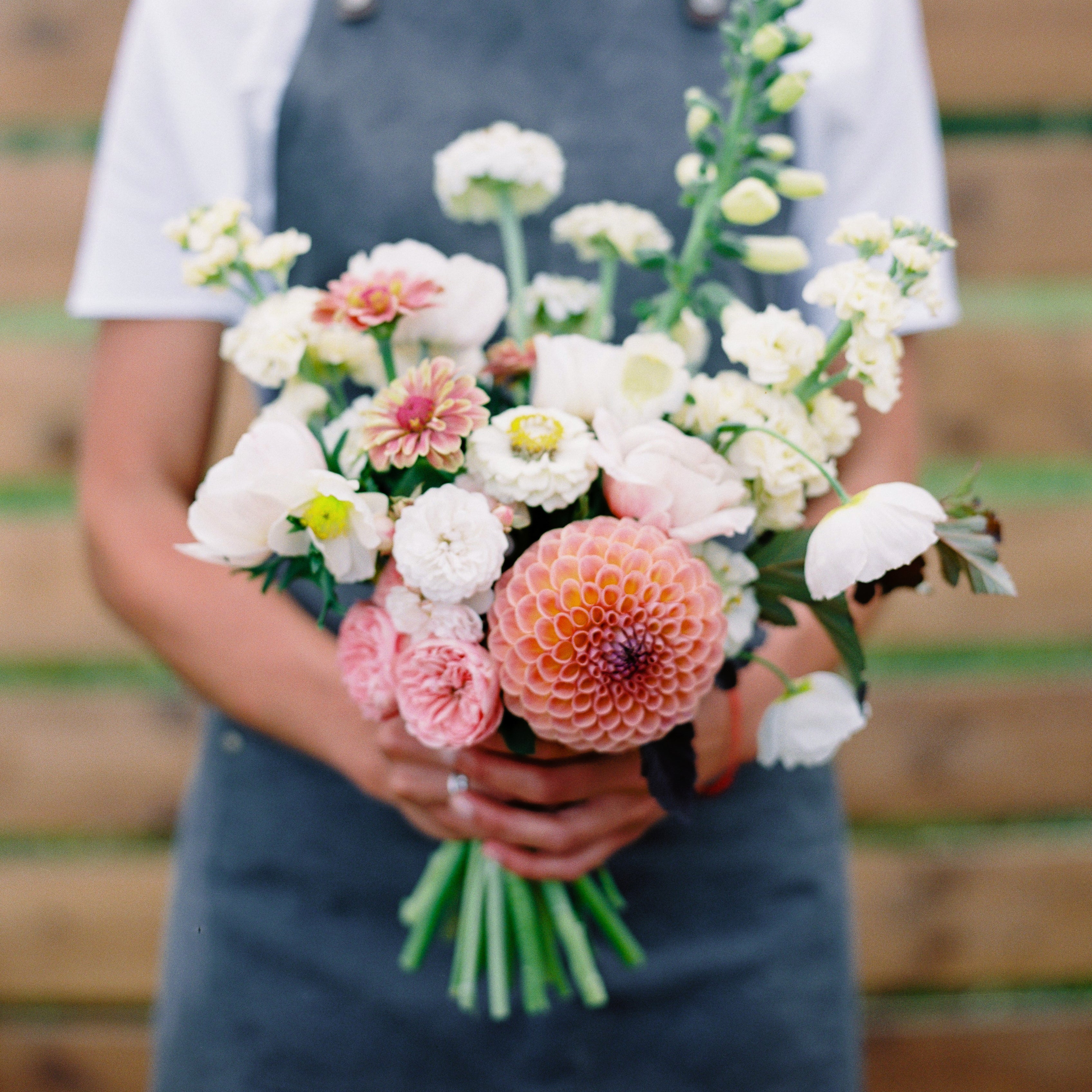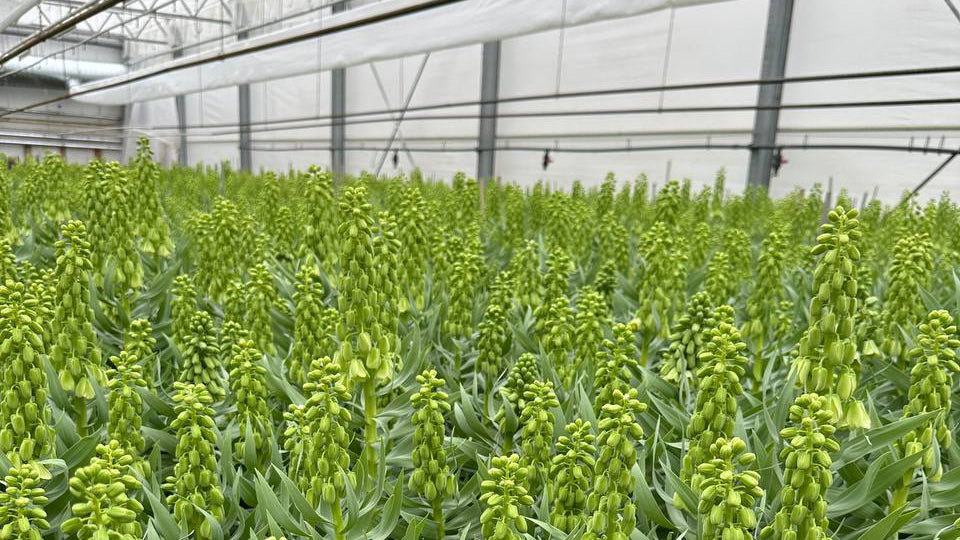Gia flowers was founded in 1990 and business was passed from father to son. Tim and Mariska started growing fritillarias in 1996. They select the most unusual varieties, constantly try different ways of growing and always strive to get flowers of the highest quality. They are always in search for more different varieties and work with breeders to improve the quality of the varieties. Most of their business income are cut flowers, but they also produce their own bulbs for sale.

Area – open fields and greenhouses.
Number of employees – around 6, plus seasonal workers at the time of planting and outdoor harvesting (students and trainees)

1.How are Fritillaria imperialis, persica and meleagris bulbs produced?
Planting material is obtained by dividing (cutting in half) the mother bulb. To do this, the bulb is deliberately deformed (cut in half) and new bulbs begin to form on the damaged edges. The process of their maturation to a bulb of size 18/20 and above, which then blooms and the quality of the flower will meet the requirements of the auction, takes about 5 years.
Bulbs of small fritillaria - meleagris, Uva vulpis are obtained from seeds. The process also takes about 5 years.
Just think how long, expensive and labor intensive the process is!

2.Requirements for soil and bulbs. How to grow them.
There are very strict requirements for the use of mineral (inorganic) fertilizers in the Netherlands, many mineral fertilizers and chemical plant protection products are prohibited. Therefore, it is important that planting material and soil are healthy from the very beginning.
Before planting in the greenhouses, the bulbs are cooled in refrigerators at a temperature of about 5 degrees. In the photo (dated 31.03) - bulbs of fritillaria after being in the cooling refrigerator since September. Pay attention to these huge roots. After cooling they are planted in plastic (lily) crates. To check if the bulb is ready for planting, cut it horizontally and check how the sprout looks like. Ideally, it should be shaped like in the photo (this is fritillaria persica). You will get a great cut flower from this bulb. You can have continuous flowering by successively planting pre-cooled bulbs and control the amount of cutting.
Tim is constantly experimenting with growing methods. For example, fritillaria meleagris, uva vulpis, akmopetala are grown in boxes in the greenhouse.
Persica and Imperialis variaties (including expensive ones) are also grown in the greenhouse in different ways (range of temperatures, planting dates). Fritillaria Persica and Imperialis are also grown in the open fields.
It is worth to note, that even such experienced farmers with vast experience behind, face the same difficulties and issues as we do, small farmers: tubers can be affected by disease, temperature conditions or planting dates will not be ideal and this will affect the quality of flowers.
During our visit, Tim hold a meeting with one of the largest meleagris bulb growers, who has been in the bulb business for 40 years, to discuss certain issues with bulbs behavior. There is no limit in the knowledge of growing farm flowers.

3.Varieties
Tim and Mariska are constantly in search for the most unusual varieties of fritillaria. They also run a lot of breeding projects. For example, over the past few years they have been working on a project with a well-known breeder to create less scented fritillaria imperialis. The new variety is called "sunset". Experienced florists will understand its value. Ask for its delivery from your suppliers.

4. Equipment
The farm has 2 tractors of different sizes, a bulb planter (automatically fills the soil into the boxes and they move and stand on a pallet), 5 coolers for bulbs and cut flowers. Metal beds pallet racks and cases for collecting cuttings that move along and across the entire growing area.
Despite the huge range of materials for greenhouse cultivation in the Netherlands, some devices on the farm are invented by themselves. Take these case holders for example. This is an expensive and complex project, but the investment and ease of use will pay off in the future.
A lot of work is done by hand - the removal and placement of plastic crates with bulbs in the greenhouse, watering and cutting. Tim, Mariska and their team work every day from early morning until it is dark. They love and are so inspired by their work that it gives them the strength to continue producing their amazing flowers.

5.Sales
Most of Gia Flowers' flowers are sold through the Dutch auction. Smaller batches of flowers also sold directly to large flower shops and via their own farm's store. Mariska opened it during the COVID-19 pandemic, when flowering was at its peak and no flowers could be sold as action has been closed. Since then, the store has been working and delighting local residents with the most unusual cut and potted flowers.
An interesting fact: only the highest quality flowers are accepted by the auction and each time they are carefully examined. Sometimes fritillarias grow with curly stems. Previously, these were considered as non-conforming and were thrown away, however, after so many florists visited the farm and showed their willingness to use flowers with natural curves, such fritillarias also began to be offered for auction, despite the fact that they are more difficult and more expensive to pack and transport. For this, Gia’s even came up with a special marking “decorative”. Sometimes they are still mistakenly considered as non-conforming, and the farm receives a fine and a downgrade. But Mariska and Tim do not give up and continue to work with the auction staff to promote the way such exceptional flowers could reach their lovers. By the way, Mariska is now studying floristics to create compositions from her own flowers.

6.Varieties range
The main flowers of Gia’s are fritillarias. These are Meleagris, Uva-Vulpis, Radeanna, Lutea, Elwessii, Ivory Bells. We couldn't photograph them all, but here are some of the more unusual ones you can see. Some varieties we saw for the first time in our life.
In addition to fritillaria, the farm grows allium and black cosmos.



1 reactie
Louise Warner
Wow, amazing interviews. I’m learning so much from them, thank you!
Laat een reactie achter
Deze site wordt beschermd door hCaptcha en het privacybeleid en de servicevoorwaarden van hCaptcha zijn van toepassing.